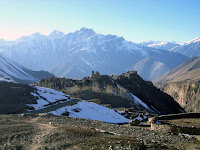Thursday, August 28, 2008
Tuesday, August 26, 2008
Sunday, August 3, 2008
Barha Gaule
Barha Gaunles are one of the himalayan indigenous communities of Nepal. They are named Barha Gaunles because they live in Barha Gaun (12 villages) of Mustang. The name is derived from the number of villages they live in. Barha Gaunles are the inhabitants of the Bahra Gauns comprising the villages above the Thak Khola River and to the south of Lho Manthang in Mustang District. Tribal chiefs or little kings had considerable influence over their territories in olden days before the reunification. This is shown by forts (dzongs) built in almost every village in this region. The forts also show the efforts of these chiefs and kings to protect their chiefdoms or kingdoms before the territorial unification of Nepal.
The main religions of Bahra Gaunle are Bon and Buddhism. ‘Gumbas’ (Monasteries) can be seen in many of the villages. There are lots of Bon pos within the villages that play vital role in their lives. They indulge in some indigenous practices. They used to practice polyandry in the past, but these are rare nowadays. Cross-cousins marriages are quite common in this community.
The main professions of this community are farming and trade. The indigenous people found in and around the sacred Buddhist temple of Muktinath are also included among the Bahra Gaunles.
Barhagaun area comprises of Muktinath, Kagbeni and other places to the south of Lhomanthang, Mustang and north of Panchgaule. Kagbeni is the centre of Barhagaun. Some have settled in Kathmandu, Jomsom and Pokhara during the course of employment and business. Their main settlement is, however, Dzong, Kagbeni and Jharkot of Muktinath . The Barhagaules are said to have come to Jharkot from Syangjung and Dzong in Tibet sometime in the past.
Subscribe to:
Posts (Atom)

